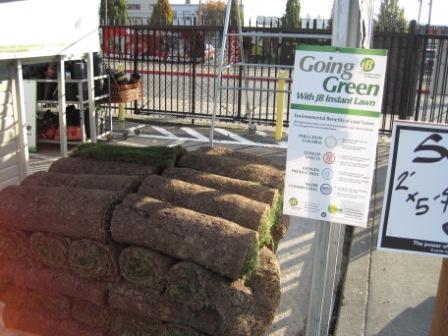I knew this one was pretty easy, but I have my reasons (below). Gold stars to KB, Jim, John, and Dave for correctly identifying rolls of sod (and they do seem thin, Peter):

Yes, sod. I dislike instant lawns; they never look good for very long, at least in my part of the country. And getting rid of sod (as we have in our landscape) is a nightmare with that *%&$^ plastic mesh in which the grass is embedded. It breaks up into little bits that are constantly coming to the surface.
I don’t have an axe to grind about lawns; my philosophy is that if you want a lawn and can afford to maintain it well, more power to you. But what’s wrong with the old fashioned way of seeding a lawn? Sure, it takes a few more weeks to "grow your own", but seeded lawns look more natural and last much longer.
I agree that seeded lawns look more natural from the start, Linda. Still, sod has its place. I know of one amazingly beautiful sod lawn that has been in place for several years now. In 2006, the local pro football stadium here in MA had just been converted to artificial turf, but international soccer matches there required that real grass be used for the playing surfaces, so sod was brought in. When the soccer tournament was over, an entire stadium’s worth of sports sod — the kind with a full two inches of rooting soil — was going to be dumped. A contractor friend learned of it, and for the cost of carting it away, he got enough sod to cover his one-acre backyard. After final loaming and grading, the sod turned what had been a giant muddy construction site for the entire previous year into smooth, jewel-green play area for the dogs and kids. It gets pretty heavy wear, but still looks wonderful four years later. (Not sure what it would have cost, though — that much soil and rooting area doesn’t come cheap, either in carbon or dollars!)
I believe you are talking about Gillette Stadium. I remember Tom Brady had a horrible game vs. the Jets. The next home game they put in artificial. I don’t know if he’s lost a regular season game at home since then.
http://www.greentechitm.com/
You do have this option for athletic fields and golf courses I do believe. I’ve been to a short course where the owner spoke about Lane Stadium at VA Tech.